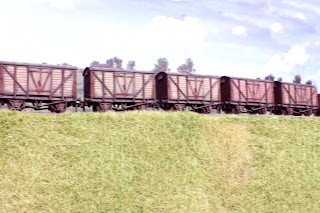When i first purchased a Heljan loco quite some time ago now i read the instructions for fitting the headcodes but found them to be a bit basic. When i was fitting them to a Western this weekend i thought why not take a couple of photos just in case anyone is in a similar situation to that which i once was.
The first problem with Heljan locos for me is removing the body. This has to be done in order to remove the glazing so that you can fit the headcode. However, unlike Bachmann models it isnt a case of unscrewing a few screws and simply removing the body. There are 4 points on the body which need to be gently prised away from their catches. Its then a case of simply pulling the body off. Its something that takes a bit of time but its important that you do it gently in order not to damage the loco. Its also something which you should preferably do before any weathering as it involves some very heavy handling of the model.
Step 1: Remove the body. The easiest way i have found to do this is find some thin pieces of card. Pieces of cut up cereal box or similar or even old train tickets work a treat. If you simply slide them in between the chassis of the loco and the plastic body where the locating catches are found (see instructions for the location). then its a case of repeating on the other 3 positions until you have something that looks like the photo below.
Once the body has been eased away its simply a case of lifting it up and off.
Step 2: Remove the head code panel glazing. This is another step that should be done with extreme care as the glazing Heljan provide is brittle at best. If you look inside the body its a case of simply pushing from the inside to out on the headcode glazing. Using your finger is the best way however if you cant fit your fingers in (like myself) then simply use a cotton bud or similar.
Step 3: The headcodes are provided by Heljan with each loco. Cut out the chosen code and place it into the void where the glazing once was. Then all you have to do is pop the glazing back in applying gentle pressure and thats it.
After doing this i then went on to give mine a medium/ heavy weathering job and the results are shown below. Alot of diesels in ye ole days suffered from poor paint adhesion so even locos that had only had the paint scheme a couple of years could get into a very worn condition. Perhaps this Western has had a few too many trips down the Dawlish and the sea air has taken it toll?
But hopefully someone will find the above of some use. I also renumbered and weathered a Hornby class 60 today which i will post a rough 'HOW TO' on later tonight. Cheers again, Scott. (The WeatheringWorks.co.uk)
Tuesday, 7 February 2012
Thursday, 2 February 2012
Photoshoppery and Distortion
Images taken today on digital cameras are almost fool proof. Stick the camera on auto mode then point and click. Its as simple as that, however things weren't always so. You only have to look back at images from the pre digital age and you see a huge amount of photos that are exposed to the wrong levels or have incorrect white balancing etc. Even today if you do take a photo slightly wrong i.e colour, exposure etc it can be largely sorted out on photoshop particularly if you are shooting in RAW format.
After looking through my photos that i have taken over the last couple of weeks i began to wonder what level or realism could be achieved with a bit of editing. Having seen others putting smoke onto their steam locos etc i decided to give it a go. Here are the results....
More images can be found on my Flickr
Im off out now but hopefully the images arent too bad!
After looking through my photos that i have taken over the last couple of weeks i began to wonder what level or realism could be achieved with a bit of editing. Having seen others putting smoke onto their steam locos etc i decided to give it a go. Here are the results....
More images can be found on my Flickr
Im off out now but hopefully the images arent too bad!
Subscribe to:
Comments (Atom)








